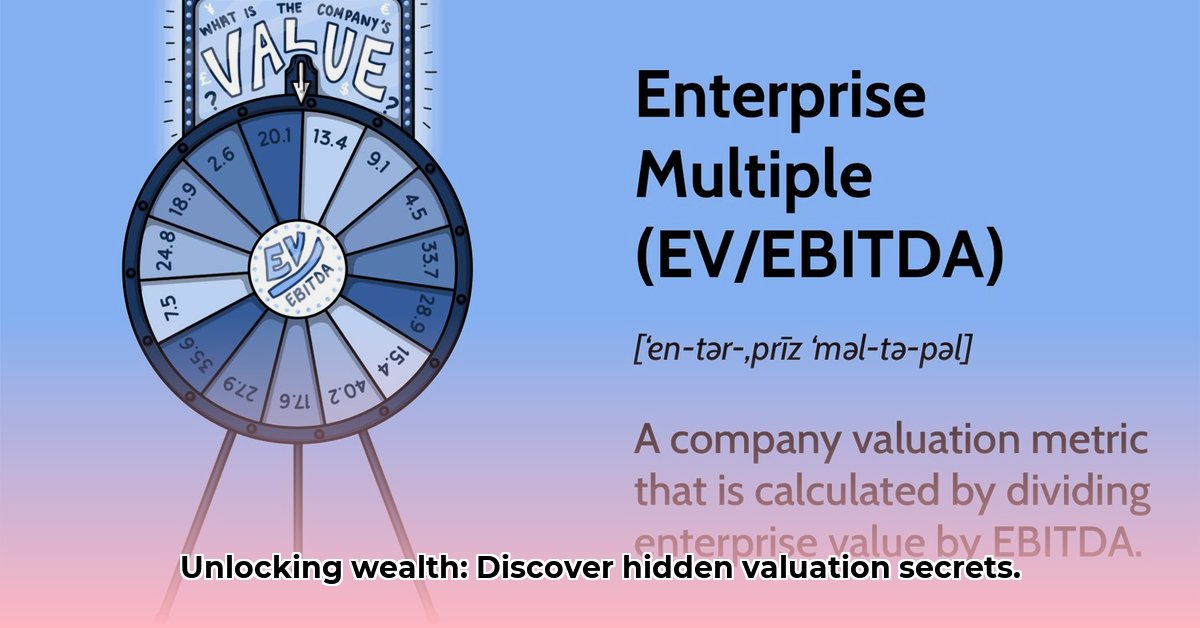# Unlocking Value: Wealth Management Firm Valuation Multiples Explained
<p>Figuring out the true worth of a wealth management firm isn't easy. It's like trying to price a unique piece of art – there's no single, simple answer. This guide cuts through the complexity, giving you the tools to understand how much a wealth management firm is really worth. We'll break down the key numbers – things like how much money the firm makes compared to its assets or profits – and show you how to use them. We'll also cover the hidden factors that can dramatically change the price, from the types of clients they have to the skills of their employees. Think of this as your cheat sheet to understanding wealth management firm valuations, helping you avoid common pitfalls and make smart decisions whether you’re buying, selling, or just plain curious.</p>
## Deeper Dive: Wealth Management Firm Valuation Multiples
Determining the fair market value of a wealth management firm requires a nuanced approach, utilizing a combination of quantitative metrics and qualitative insights. It's not just about crunching numbers; it's about understanding the story behind the numbers and the unique characteristics of the business. This guide provides a detailed exploration of valuation multiples, offering a framework for understanding the key drivers of value in the wealth management industry.
### Core Valuation Multiples: Understanding the Fundamentals
Valuation multiples are ratios that compare a company's market value to a specific financial metric. They provide a relative measure of value, allowing for comparisons between similar firms. In the wealth management industry, several key multiples are commonly used:
* **Enterprise Value to Revenue (EV/Revenue):** This multiple compares the total enterprise value of the firm (market capitalization plus debt, minus cash) to its annual revenue. It reflects how much investors are willing to pay for each dollar of revenue generated by the firm. A higher EV/Revenue multiple may indicate stronger growth prospects or a more valuable brand.
* **Enterprise Value to Assets Under Management (EV/AUM):** This is a widely used metric in the wealth management industry. It compares the enterprise value of the firm to the total value of assets it manages on behalf of its clients. It reflects the market's perception of the firm's ability to generate revenue from its AUM. Higher multiples generally reflect a stronger brand, higher client retention rates, or a more desirable client base.
* **Enterprise Value to Earnings Before Interest, Taxes, Depreciation, and Amortization (EV/EBITDA):** This multiple compares the enterprise value of the firm to its EBITDA, a measure of operating profitability. It reflects how much investors are willing to pay for each dollar of earnings generated by the firm before taking into account financing and accounting decisions. A higher EV/EBITDA multiple may indicate a more efficient operation, higher growth potential, or a stronger competitive position.
**Multiple Ranges and Interpretation:** It's important to note that valuation multiples are not absolute indicators of value. Typical ranges for these multiples vary depending on factors such as firm size, growth rate, profitability, and market conditions. Consulting industry reports and valuation experts can provide valuable benchmarks for interpreting these multiples.
### Beyond the Numbers: Qualitative Factors Driving Valuation
While valuation multiples provide a quantitative framework, they don't capture the full picture. Qualitative factors play a significant role in determining the value of a wealth management firm:
* **Client Base:** The composition and quality of the client base are critical. Factors to consider include:
* **Client Demographics:** High-net-worth clients are generally more valuable than mass affluent clients due to the higher fees they generate and their lower attrition rates.
* **Client Retention:** A high client retention rate indicates strong client satisfaction and reduces the risk of revenue loss.
* **Client Concentration:** A firm that relies heavily on a few large clients is more vulnerable to revenue fluctuations if one of those clients leaves.
* **Growth Potential:** The potential for future growth is a key driver of valuation. Factors to consider include:
* **Organic Growth:** The ability to attract new clients and increase AUM through marketing and referrals.
* **Inorganic Growth:** The potential for acquisitions and mergers to expand the firm's reach and AUM.
* **Operational Efficiency:** A well-managed firm with efficient operations will be more profitable and valuable. Factors to consider include:
* **Technology Infrastructure:** The firm's use of technology to streamline processes and improve client service.
* **Compliance and Risk Management:** A strong compliance program and effective risk management practices reduce the potential for regulatory fines and reputational damage.
* **Management Team:** The experience, expertise, and stability of the management team are critical to the firm's success. A strong management team can attract and retain talent, drive growth, and navigate challenges.
* **Brand Reputation:** A strong brand reputation can attract new clients and command higher fees.
### Step-by-Step Valuation: A Practical Approach
Valuing a wealth management firm is a multi-step process that requires careful analysis and judgment:
1. **Gather Financial Data:** Collect financial statements, including income statements, balance sheets, and cash flow statements, for the past several years. Obtain information on AUM, client demographics, and revenue sources.
2. **Calculate Valuation Multiples:** Calculate the relevant valuation multiples (EV/Revenue, EV/AUM, EV/EBITDA) using the financial data.
3. **Benchmark Against Industry Data:** Compare the calculated multiples to industry benchmarks and comparable transactions to assess the firm's relative valuation.
4. **Analyze Qualitative Factors:** Evaluate the qualitative factors discussed above, such as the client base, growth potential, operational efficiency, management team, and brand reputation.
5. **Adjust Valuation:** Adjust the initial valuation based on the analysis of qualitative factors. Consider both positive and negative factors that may impact the firm's value.
6. **Consider Different Valuation Methods:** Explore other valuation methods, such as discounted cash flow analysis, to corroborate the results obtained using valuation multiples.
7. **Seek Expert Advice:** Consult with valuation professionals who have experience in the wealth management industry to obtain an independent opinion on the firm's value.
### Stakeholder Perspectives: Understanding Different Motivations
The perceived value of a wealth management firm can vary depending on the stakeholder involved:
| Stakeholder | Key Considerations |
| :----------------------- | :------------------------------------------------------------------------------------------------------------------------------------------------------------------------------------ |
| Firm Owners (Selling) | Maximizing the sale price, ensuring a smooth transition for clients and employees, and securing their financial future. |
| Firm Owners (Buying) | Identifying a strategic acquisition target, integrating the new firm effectively, achieving synergies and cost savings, and generating a return on investment. |
| Investors | Assessing the risk-reward profile of the investment, evaluating the firm's growth potential and profitability, and understanding the competitive landscape. |
| Valuation Consultants | Providing an objective and unbiased valuation, adhering to professional standards, and considering all relevant factors that may impact the firm's value. |
### Managing Risk: Protecting and Enhancing Value
Effective risk management practices are essential for preserving and enhancing the value of a wealth management firm:
* **Compliance:** Maintaining a robust compliance program to adhere to regulatory requirements and avoid legal and reputational risks.
* **Cybersecurity:** Implementing strong cybersecurity measures to protect client data and prevent cyberattacks.
* **Succession Planning:** Developing a succession plan to ensure a smooth transition of leadership and maintain business continuity.
* **Client Retention:** Implementing strategies to retain clients and minimize attrition.
### The Regulatory Environment: Navigating Complexity
The wealth management industry is subject to a complex and evolving regulatory environment. Staying informed about regulatory changes and ensuring compliance is essential for maintaining a firm's value. Key regulatory considerations include:
* **Securities and Exchange Commission (SEC) regulations:** Compliance with SEC rules regarding investment advice, disclosure, and client protection.
* **Financial Industry Regulatory Authority (FINRA) regulations:** Adherence to FINRA rules governing broker-dealer activities and sales practices.
* **State regulations:** Compliance with state laws and regulations governing investment advisory activities.
### Conclusion: A Holistic View of Value
Valuing a wealth management firm is a complex undertaking that requires a holistic approach. By combining quantitative analysis with qualitative insights and considering the perspectives of different stakeholders, it's possible to arrive at a fair and accurate assessment of value. Seeking the guidance of experienced valuation professionals can provide valuable support in navigating this complex process.
Latest posts by Xiao Txgenco (see all)
- How Did Charles F. Brush Discover Wind Energy Tech? - November 19, 2025
- Wind Energy Vertical: Weighing the Pros and Cons of Wind Power - November 16, 2025
- How Much Energy Does a Wind Turbine Actually Create? - November 14, 2025
















